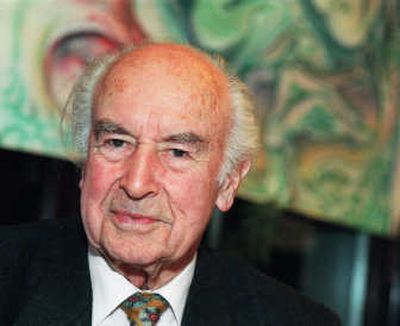Chemist who accidentally discovered LSD dies at 102

Albert Hofmann, the Swiss chemist who discovered LSD and thereby gave the psychedelic generation the pharmaceutical vehicle to turn on, tune in and drop out, has died. He was 102.
Hofmann died Tuesday morning at his home in Basel, Switzerland, of a heart attack.
Hofmann also identified and synthesized the active ingredients of peyote mushrooms and a Mexican psychoactive plant called ololiuqui and developed at least three related, non-psychoactive compounds that became widely used in medicine.
Those other feats would have been little remembered, however, had he not accidentally gotten a trace amount of an experimental compound called lysergic acid diethylamide on his fingertips and taken the world’s first acid trip.
Hofmann was a talented synthetic chemist working in the Basel research center of Sandoz Laboratories – now Novartis – in the 1930s when he began studying the chemistry of ergot, the common name for a fungus that grows on rye, barley and certain other plants.
In the early 1930s, U.S. researchers had identified the primary active ingredient of ergot, a chemical called lysergic acid. Hofmann devised a technique to make a series of derivatives of lysergic acid called amides and began systematically looking for medically useful compounds.
On April 16, 1943, Hofmann had just completed synthesizing a batch of was lysergic acid diethylamide when, he subsequently wrote to his supervisor, “I was forced to interrupt my work in the laboratory in the middle of the afternoon and proceed home, being affected by a remarkable restlessness, combined with slight dizziness.
“At home, I lay down and sank into a not-unpleasant intoxicated-like condition, characterized by an extremely stimulated imagination. In a dreamlike state I perceived an uninterrupted stream of fantastic pictures, extraordinary shapes with intense, kaleidoscopic play of colors. After some two hours, this condition faded away.”
Hofmann suspected that the state had been caused by something in the lab. In an interview on his 100th birthday, he said, “I didn’t know what caused it, but I knew that it was important.”
The next week, he took what he considered to be an extremely small dose of LSD. He had planned to gradually increase the dosage but instead was surprised to encounter the first bad acid trip.
LSD was initially hailed as a wonder drug for use in psychoanalysis, particularly for gaining insights into schizophrenia; and more than 2,000 research papers appeared over the succeeding decade.
The Central Intelligence Agency investigated LSD as a potential agent for mind control, and the British government studied it as a truth drug.
But in the 1960s, largely at the instigation of Harvard University psychologists Timothy Leary and Richard Alpert, LSD began to be seen first as a pathway to spiritual enlightenment, then as a major recreational drug.
“Instead of a ‘wonder child,’ LSD suddenly became my ‘problem child,’ ” Hofmann said.
In 1966, the United States banned its use, followed by most other countries.